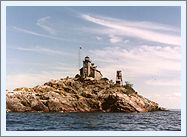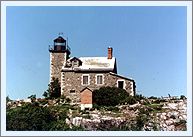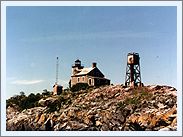|
Historical
information

Local Indians had no reason
or desire to go to Na-Be-Quon Island. The small 2½-acre island was
barren save for a few strawberries, currants and raspberries growing
from cracks between the rocks. When first explored by white people in
the 1830's, the granite outcropping that would appropriately become
known as Granite Island, was still a forbidding place. Even in such a
small surface area, the island rose to a height of 60 feet above the
lake, and its convoluted and craggy shoreline made landing virtually
impossible.
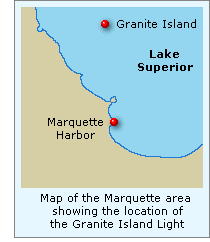 With the discovery of iron ore in the
area around 1840, Marquette was fast becoming one of the busiest ports
in the Upper Peninsula, and Granite's Island's location approximately
twelve-and-a-half miles to the northeast, represented a major threat to
vessels making passage to and from the harbor. With the discovery of iron ore in the
area around 1840, Marquette was fast becoming one of the busiest ports
in the Upper Peninsula, and Granite's Island's location approximately
twelve-and-a-half miles to the northeast, represented a major threat to
vessels making passage to and from the harbor.
On March 2, 1867, Congress appropriated
$20,000 for construction of a lighthouse on the island. The lighthouse
tender "Haze" delivered a construction crew and building
supplies to the island in the spring of 1868, and the crew began
construction with the blasting of a flat spot for the structure's
foundation at the island's highest point. The structure itself was built
of undressed hard granite taken from the Huron Islands, and consisted of
a ten foot square, forty foot high tower attached to a 2,408 sq. ft.,
two-story keepers dwelling. Since no landing dock was planned, davits
were installed at the water's edge to allow the keeper's sailboat to be
hauled to safety onshore.
Finally, the tower was outfitted with a
Fourth Order Fresnel lens at a focal plane of 89 feet, and was exhibited
for the first time on October 20 of that same year. While it was
initially recommended that the station be outfitted with a foghorn, none
was installed at the time of construction.
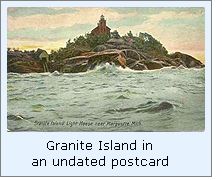 Frequently enshrouded by fog, the
keepers repeatedly complained of the need for a fog signal. Their
complaints falling on deaf ears until the bell from Thunder Bay Island
was replaced with a steam whistle, and the old bell was shipped to
Granite Island, where it was installed in a newly constructed tower at
the rear of the keepers quarters. Powered by an oil-powered steam engine
located in the room below, the bell sounded every five minutes, warning
mariners of the island's existence. Frequently enshrouded by fog, the
keepers repeatedly complained of the need for a fog signal. Their
complaints falling on deaf ears until the bell from Thunder Bay Island
was replaced with a steam whistle, and the old bell was shipped to
Granite Island, where it was installed in a newly constructed tower at
the rear of the keepers quarters. Powered by an oil-powered steam engine
located in the room below, the bell sounded every five minutes, warning
mariners of the island's existence.
The annual report of the Lighthouse
Board in 1890 listed the station as being equipped with a fixed white
Fourth Order Fresnel lens, varied by a red flash every 90 seconds. Therefore,
we assume that the lens was retrofitted with a flash panel at some time.
A counterweighted clockwork occulting mechanism controlled the rotation
of the lens.
In 1905, a concrete block oil house was
built on the island, and the following year a boat landing was built on
the north side along with a new boathouse, trestle and winch.
 Life on this lonely outpost was spartan
at the least. While located a relatively short twelve miles from land,
the distance may as well have been a thousand miles. Rough seas,
combined with extremely difficult landing conditions made every trip to
Marquette a life threatening adventure. However, this life must have
suited keeper James Wheatley well, since he was the longest serving
keeper in the station's history. Serving on the island for 30 years from
1885 to 1915, he retired from service at the age of 83, and personally
experienced the fury that the waters around Granite Island could bring. Life on this lonely outpost was spartan
at the least. While located a relatively short twelve miles from land,
the distance may as well have been a thousand miles. Rough seas,
combined with extremely difficult landing conditions made every trip to
Marquette a life threatening adventure. However, this life must have
suited keeper James Wheatley well, since he was the longest serving
keeper in the station's history. Serving on the island for 30 years from
1885 to 1915, he retired from service at the age of 83, and personally
experienced the fury that the waters around Granite Island could bring.
Wheatley's son, William, drowned in a
squall in 1898 on his way to the island in a small sailboat to visit
with his father. In the fall of 1903, Wheatley's assistant John McMartin
launched the station boat to set out for Marquette, when a wave capsized
the boat, tossing McMartin into the water. Wheatley could only stand and
watch in horror as the waves pounded McMartin against the rocks of the
island, eventually to disappear and drown. (Anna Carlson, the wife of
the Marquette keeper, was transferred to Granite Island for ten days to
fill-in for the dead assistant until a full time replacement arrived.)
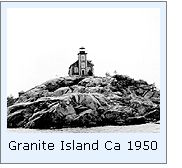 While some island lighthouse keepers
were able to plant gardens for both food and to while away the long
hours, such activity on Granite Island was impossible. However, local
lore has it that one of the keepers managed to coax rhubarb into growing
between some of the cracks in the rocks. At one time there was a tree on
the island, but it is unknown as to whether it rooted of its own accord,
or was planted by one of the keepers. While some island lighthouse keepers
were able to plant gardens for both food and to while away the long
hours, such activity on Granite Island was impossible. However, local
lore has it that one of the keepers managed to coax rhubarb into growing
between some of the cracks in the rocks. At one time there was a tree on
the island, but it is unknown as to whether it rooted of its own accord,
or was planted by one of the keepers.
With the 1939 takeover of the
Lighthouse Service by the Coast Guard, and with a decline in vessel
traffic running between the island and the mainland, the Granite Island
Light was considered a prime candidate for automation.
In the fall of 1939, the fog bell and
furnishings were removed, acetylene tanks were installed in a
steel-sided shed by the tower, and the light was automated. Today the
light is exhibited from a modern lens powered by a solar powered battery
system.
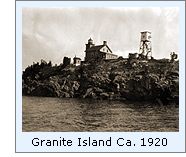 In the latest chapter in the Granite
Island story, in 1999, the Coast Guard decided that a number of the
lighthouses in inventory were considered to be "in excess,"
and announced that they would receive bids on the property through June
15, 1999. Granite Island was among these excess lights, and Scott Holman
of Freeland, Michigan submitted the highest bid of $86,000, took title
to the island, and is now the station's newest "keeper." In the latest chapter in the Granite
Island story, in 1999, the Coast Guard decided that a number of the
lighthouses in inventory were considered to be "in excess,"
and announced that they would receive bids on the property through June
15, 1999. Granite Island was among these excess lights, and Scott Holman
of Freeland, Michigan submitted the highest bid of $86,000, took title
to the island, and is now the station's newest "keeper."
Holman, a longtime explorer of Great
Lakes Shipwrecks has plans to restore the station, and maintains a web
site dedicated to his new island. Click here
to visit Scott's Granite
Island web site.

Keepers of
this Light

Click here
to see a complete listing of all Granite Island Light keepers compiled
by Phyllis L. Tag of Great Lakes Lighthouse Research.

Seeing this Light

We have yet to visit this
light, and thus have nothing to report at this time. Since we do not
expect to have access to a seaworthy vessel until 2001, it is unlikely
that we will be able to photograph this light until then.

Finding this Light

Located in the sometimes treacherous open water of Lake Superior,
approximately 11 miles north of Marquette, Granite Island Light is
virtually inaccessible to all but the most seasoned mariner. There are a
number of charter boats services that are happy to take "lighthouse
nuts" out into the lake to view Granite Island Light. For example,
"Uncle Ducky Charters" offers trips that take six-passenger
tours of Stannard's Rock, Granite Island and Marquette harbor for
$120.00 per person. Click here to visit the Uncle Ducky website.

Reference Sources

Annual reports of the Lighthouse
Board, various, 1853 - 1909
Inventory of Historic Light Stations,
National Parks Service,
1994.
Lighthouse Digest, July 1998 & December 1999.
Granite Island Website, Scott Holman.
Apostle Islands Scrapbook, National Park Service.
No personal observation as of this update.
Keeper listings for this light appear courtesy of Great
Lakes Lighthouse Research
|
